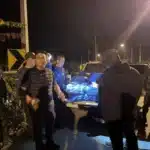ROME – A restoration site beside the Colosseum became the scene of a fatal accident on Monday, adding a fresh layer of sorrow to central Rome. Part of the 13th-century Torre dei Conti, a towering medieval landmark under refurbishment, gave way and trapped a worker for 11 hours beneath heavy rubble.
Rescuers pulled out 66-year-old Romanian labourer Octav Stroici alive, but he died shortly after reaching the hospital, ending a long effort that had held public attention across Italy and abroad.
The collapse happened a few metres from Via dei Fori Imperiali and has sparked anger over workplace safety, along with worries about the condition of historic structures during intense redevelopment.
Prime Minister Giorgia Meloni expressed deep sadness and thanked the teams who fought to save Stroici, noting the dedication of Romanians working far from home. Romanian President Klaus Iohannis paid tribute as well, saying the worker represented the quiet determination of people trying to build a better future.
Sudden Failure in the Heart of Rome
Built in 1228 by Riccardo Conti, brother of Pope Innocent III, the Torre dei Conti originally rose to around 50 metres as a fortified symbol of the Conti family’s strength. Earthquakes in 1349 and 1695 reduced it to roughly 29 metres, leaving a sombre presence above the Roman Forum.
The building had been empty since 2006 after years as municipal offices, with city records citing failing false ceilings, rotten timbers, and extensive water damage.
Using nearly 7 million euros from the European Union’s post-pandemic recovery fund, a four-year project aimed to stabilise and convert the tower into a museum and conference venue by mid-2026. Eleven workers from two contractors were on site that morning, carrying out structural bracing and façade works. At around 11:20 a.m., the structure partially failed without any signal of trouble.
Witnesses heard a huge roar as dust surged into the street. Gaetano La Manna, a 66-year-old colleague who escaped with cuts to his face and head, said he heard a bang and then everything collapsed. The first failure hit the southern buttress and sloping base, pushing masonry inward and trapping Stroici on an upper level. Firefighters moved fast to remove two other workers by aerial ladder, shielding them from debris as the tower shed more material.
About 140 firefighters, engineers, and medical teams joined the rescue. Drones mapped the voids as crews used hydraulic equipment to make a path, but the situation worsened roughly 90 minutes later when the stairwell and roof sections gave way, burying Stroici under fresh rubble.
No rescuers were hurt, since teams had installed protective barriers in time. Rome’s prefect, Lamberto Giannini, said they did everything possible to shield the worker while drilling toward him to deliver oxygen and maintain contact. Stroici stayed conscious, responding with shouts and gestures as crews edged closer.
At about 10:30 p.m., firefighters lifted him onto a stretcher via a telescopic ladder. People gathered along the cordon, phones lit, cheering as he was lowered from the ruin. Rome’s mayor, Roberto Gualtieri, who was at the site with Culture Minister Gennaro Sangiuliano, called it a delicate operation with constant risk of more collapse.
Hopes quickly faded. Health officials said Stroici suffered crush injuries and internal bleeding and died while being taken to Umberto I Polyclinic or soon after arrival. Another Romanian worker had minor injuries and was discharged after tests.
Fragility and Possible Causes
A debate grew on Tuesday about what triggered the collapse. Some cited a 3.3-magnitude offshore quake near Lazio on Saturday, which was faintly felt in Rome and may have strained the tower’s already weakened structure.
Others pointed to vibrations from construction on the new metro line at Piazza Venezia, part of major infrastructure works ahead of the 2025 Jubilee that could bring an estimated 32 million pilgrims. Local pharmacist Elena Cerchi, who works nearby, said the city feels fragile and that deep drilling in the centre makes many residents uneasy.
Police sealed off the area and set up patrols. The tower’s surface remains scarred yet still standing, a stark outline against the Forum. Visitors lingered at the barricades, taking photos with the damaged site in the background, a bleak contrast in a city built on layers of history and loss.
Prosecutors in Rome have opened a case for manslaughter, negligent disaster, and grievous bodily harm. Sources said investigators are focusing on site managers and engineers, checking adherence to safety rules, structural surveys, and the adequacy of temporary supports.
Giannini said rescuers faced constant setbacks, with new collapses burying limbs as soon as they were freed. Forensic engineers from the culture ministry began work on Tuesday, sifting the debris, with initial findings expected within days.
The incident highlights Italy’s persistent workplace death toll. INAIL recorded 575 fatalities in the first nine months of 2025, many linked to construction.
Unions condemned what they called preventable failings, urging a nationwide review of heritage restoration sites funded by EU money. Romania’s foreign ministry praised Italian emergency services and offered support to Stroici’s family. His wife waited at the site throughout the rescue.
As Rome grieves, the Torre dei Conti stands with other reminders of vulnerability, from Pompeii’s ancient houses to churches ruined in the 2016 Amatrice earthquake. Mayor Gualtieri said the city must act faster on safety so that history does not crumble.
For Stroici, a father and provider far from the Carpathians, Rome did not bring triumph, only a final message written in dust.
Source: The Associated Press















